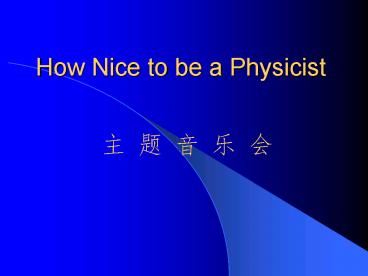How Nice to be a Physicist - PowerPoint PPT Presentation
1 / 30
Title:
How Nice to be a Physicist
Description:
Both British and US pathfinders used this microwave system to perform a useful ... then a long and continuing career working with computer systems and networks. ... – PowerPoint PPT presentation
Number of Views:30
Avg rating:3.0/5.0
Title: How Nice to be a Physicist
1
How Nice to be a Physicist
- ? ? ? ? ?
2
Contents How Nice
to be a Physicist --- by Arthur Roberts (Prof.
of Physics) Songs by Walter Smith (Assoc. Prof.,
Haverford) and his students Maxwell
Equations --- by Lynda Williams Romance for
Physicists --- by Silvano Gennaro
3
How Nice to be a Physicist --- by Dr. Arthur
Roberts
4
Arthur Roberts Arthur Roberts, retired particle
physicist and a musician and composer, died in
Honolulu, Hawaii, on 22 April 2004. His career
included 60 years of particle physics and
contributions to medicine, national defense, and
music. Born on 6 July 1912 in New York City,
Art received his BS in physics at the City
College of New York in 1931 and his MA in
physics from Columbia University in 1933. Three
years later, he received his PhD in physics from
New York University. He also earned an MA in
piano performance in 1933 from the Manhattan
School of Music, where he met a voice major who
would later become his wife of more than 60
years. During the late 1930s, Art held joint
appointments with the MIT cyclotron group and
Harvard Medical School and also taught at the
New England Conservatory of Music. He received
the Award of Honor in 1976 from the New England
chapter of the Society for Nuclear Medicine. Art
joined the MIT Radiation Laboratory in 1941 to
head a group that developed microwave
"beacons". During World War II, the British
civilian radar organization, Telecommunications
Research Establishment, had developed a radar
system codenamed Oboe Art's group converted the
Oboe system to microwave frequencies after the
Germans learned to jam the lower-frequency
British system. Both British and US pathfinders
used this microwave system to perform a useful
portion of their strategic bombing from 1944 to
1945. Art received a Presidential Certificate of
Merit (1948) from President Harry S Truman for
that work. Following the war, Art joined the
University of Iowa, where he and his
collaborators measured the magnetic moment of the
neutron and deuteron. In 1950, he moved to the
University of Rochester, Art helped found the
Rochester Conference series (now called the
International Conference on High Energy Physics).
In 1960, Art joined Argonne National
Laboratory, In 1967, he joined the fledgling
National Accelerator Laboratory (now Fermilab)
He served as chairman of the physics department
from 1972 to 1973.
5
(No Transcript)
6
Walter Smith Associate Professor of Physics,
Haverford College Courses in 2005 Solid
State Physics Electronic Instrumentation
Computers. Research Interests
Summary Nanoscale and molecular
electronics Porphyrin Nanorods Electrical
breakdown of carbon nanotubes
7
(No Transcript)
8
(No Transcript)
9
(No Transcript)
10
(No Transcript)
11
(No Transcript)
12
(No Transcript)
13
(No Transcript)
14
(No Transcript)
15
(No Transcript)
16
(No Transcript)
17
(No Transcript)
18
(No Transcript)
19
(No Transcript)
20
(No Transcript)
21
(No Transcript)
22
Maxwell Equations --- by Lynda
Williams
23
- Lynda Williams
- Physics and Astronomy Instructor
- at San Francisco State University
- MS in Physics,
- San Francisco State University
- BA in Mathematics,
- California State University, Sacramento
24
Maxwell equations
Maxwell's Equations -Faraday's Law
Maxwell's Equations -Ampere's Law
Maxwell's Equations in Vacuum
25
Romance for Physicists --- by Silvano
Gennaro
26
(No Transcript)
27
(No Transcript)
28
Thank you !!! For more songs, please visit
http//www.physicssongs
.org
29
A LYRIC-WRITING CONTEST --- by Physics Today
Bring out your inner muse! To help celebrate the
World Year of Physics, we asked Michael
Mendelson to "write an appropriate piece of music
for us to publish. It will need to be
sophisticated, fun, somewhat difficult, and
infinitely rewarding just like physics!"
Submissions must be received by 15 October
2005. They may be e-mailed to entanglement_at_aip.or
g The most captivating and engaging entry or
entries, as judged by our editors, will appear
in the December 2005 issue of Physics
Today. Mendelson got his physics bachelor's
degree in 1971 from the University of
California, Berkeley, where he also enjoyed the
folk-music scene. He followed that with a
master's degree in Comparative Folklore and
Mythology from UCLA, then a long and continuing
career working with computer systems and
networks. All along the way, he has composed and
played music.
30
(No Transcript)































